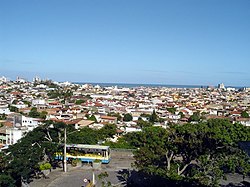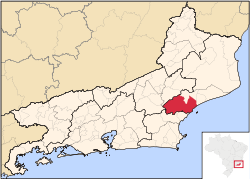Macaé
This article needs additional citations for verification. (January 2010) |
Macaé | |
|---|---|
 Macaé skyline | |
| Nickname(s): "Princesinha do Atlântico, ou A Moreninha, ou Capital do Petróleo Brasileiro" Little Princess of Atlantic, or The Little Brunette or The Brazilian Capital Oil | |
 Location in the state of Rio de Janeiro and Brazil | |
| Country | Brazil |
| Region | Southeast |
| State | Rio de Janeiro |
| Founded | July 29, 1813 |
| Government | |
| • Mayor | Aluízio dos Santos Júnior (PV) |
| Area | |
• Total | 1,216 km2 (469 sq mi) |
| Population (2011)[1] | |
• Total | 212,433 |
| • Density | 159.88/km2 (413.91/sq mi) |
| Time zone | UTC-3 (UTC-3) |
| • Summer (DST) | UTC-2 (UTC-2) |
| Website | www.macae.rj.gov.br |
Macaé (Portuguese pronunciation: [mɐkɐˈɛ]) is a municipality located in the Brazilian state of Rio de Janeiro, 180 km northeast of the state capital. Its population was recorded as 206,748 in 2010 and its municipality covers an area of 1,216 km².[2]
Macaé is generally considered to be the centre of the Brazilian offshore petroleum industry and it is often referred to as "Cidade do Petróleo" ("City of Petroleum"). The Brazilian state-controlled oil company Petrobras has many facilities within the town. Macaé is one of the fastest-growing cities in Brazil, with a growth of 600% within the last 10 years.[3] Benedito Lacerda Airport is served by scheduled flights and concentrates operations to off-shore platforms.
Other economic activities in the city include tourism and fishing. These two sectors were very important for the city's revenues before the 1980s. The city has a growing reputation for high-quality technical education and training.[4]
Although the city has some touristic potential, the lack of investiments on this area makes its growth to be very small. Its most famous beaches are Cavaleiros and Pecado. The interior of the municipality has small rural towns such as Sana and Frade.
Demography
In 2009 the Brazilian Institute of Geography and Statistics (IBGE) estimates the population of Macaé as 194.413 inhabitants. The National Department of Transit (Denatran) census in 2003 recorded a fleet of 36.821 vehicles. According to the Electoral Regional Court (TRE-RJ) the number of voters registered in Macaé was 97.184 in 2004, divided in two electoral zones and 268 sections. In the last elections, 84,054 (200.49%) people voted.
The city has an expatriate community (mainly English speakers) of around 1,000 people[citation needed] - many of whom are connected directly or indirectly to the oil and gas industry.
Economy
Since the 1970s, when Petrobras chose Macaé to site its headquarters in the Campos Basin, the city has had a population boom. More than four thousand companies have set up offices in the city and its population has tripled since. High-quality hotels have been constructed and a wide variety of service industries have recently sprouted up.
The city has the biggest tax generation of new ranks of work of the interior of the state, according to research conducted for the Federation of Industries of Rio de Janeiro (Firjan): 13.2% to the year. The economy of the city has grown 600% since 1997. Surveys conducted in past years for IBGE demonstrated that the Internal Gross Product (in Portuguese, Produto Interno Bruto - PIB) per capita of the city in 2007 is R$37.667,00 per year, 200% greater than the national average- and the average salary is 8.2 times the minimum salary, making Macaé the city with the highest wages in the Rio de Janeiro State.[5]
Education
While the city holds various public and private schools for primary and secondary education, there are limited options at the university level. The institutions of higher education focus mainly on trade labor and industry-related technical training. Fundação Getúlio Vargas, a renowned Brazilian institution of higher education holds a satellite campus in Macaé, offering degrees in business management, economics, law and social sciences.
Twin Towns - sister cities
External links
- Macaé City Hall Template:Pt icon
- News about Petróleum and Gas at Bacia de Campos Template:Pt icon
- Petrobras Template:En icon/Template:Pt icon
References
This article includes a list of general references, but it lacks sufficient corresponding inline citations. (December 2008) |



